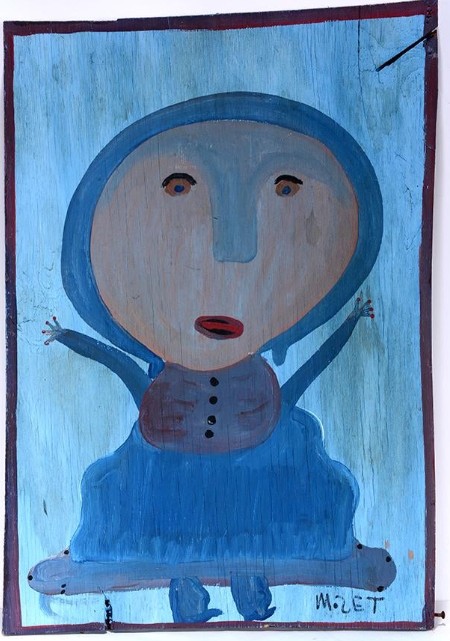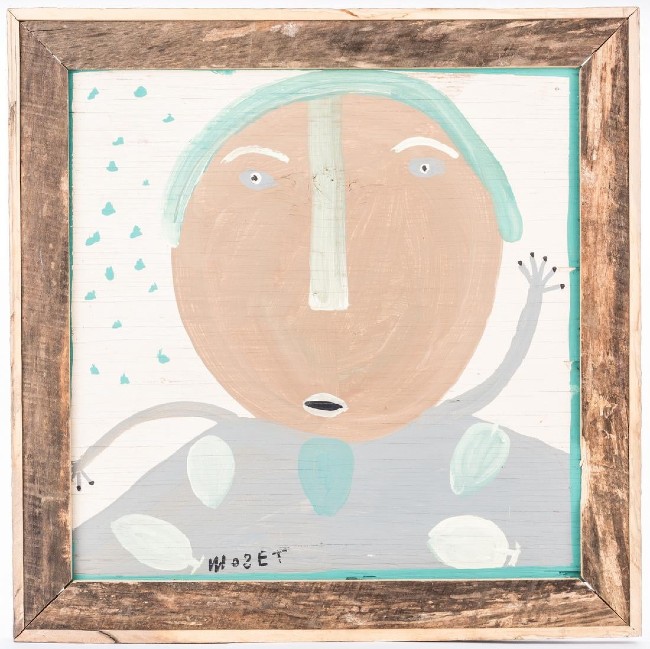
NEW YORK – One of the most renowned self-taught artists, Mose Tolliver (1918-2006) painted pictures that were deceptively simple – a red bird, a dancing woman, self-portraits or a figure on a cross – but when considered together, paint a picture of life in the American South as well as explore themes of race, religion and class.
A self-taught artist who grew up as one of 12 children born in Alabama to sharecropper parents, Tolliver worked many jobs, including manual labor, farming, painting houses and landscaping. Like several other iconic folk artists, art came late in life to him. In the late 1960s, he sustained severe injuries at work in a furniture factory when his legs were crushed under a load of marble that fell on him. During the long recovery, he was inspired to take up painting. In widely reported conversations with major art collector William Arnett in the ’80s and ’90s, Tolliver said he had a lot of time on his hands to paint and was easily able to acquire wood to paint on.

“He really embodies what the total self-taught art movement was about,” says Steve Slotin, co-owner of Slotin Folk Art Auction in Buford, Georgia. “Here is an African American man who was injured while working and really was not able to do much but be bedridden. His creative juices were still flowing in him, though, so late in life he decided to become an artist.”
One of the most widely collected self-taught artists, Tolliver mostly used house paint to create his artworks and is renowned for his vivid and often abstracted pictures, many of which were whimsical images of fruit, landscapes, people and animals. Preferring a limited color palette, he favored browns, blues and reds. He painted prolifically and is said to have painted about 10 works a day. His titles were almost an afterthought and usually given off-the-cuff, irreverent titles such as Smoke Charlies, Lady on Scooter or That’s Me. He reportedly was in the habit of turning his paintings 180 degrees and painting secondary subjects such as animals or a landscape upside down to accompany the main image.

“The visual appeal [of his artwork] … is childlike but it is done by an African American man in his later years. He was already a grandfather by then,” Slotin said. “Most people at that age are already done with their careers and not thinking about becoming an artist and he did. He did it without any influence or any art training. It was strictly from the heart and just driven by a passion to create.”
In his early days before becoming a recognized artist, he often hung his artworks from a tree at his home in Montgomery, Ala., selling them for a dollar or two each. “He rarely sold any of them, no matter what the price. He just painted because he wanted to,” according to New Orleans gallery Anton Haardt Gallery’s artist bio. Slotin echoed these sentiments, adding that Tolliver painted whatever he wanted from people to animals and houses, mostly using found wood. Tolliver himself was quoted in past interviews as having said he started out painting on tree stumps he found. “He really wasn’t painting to have the art world come to him and be an artist,” Slotin said. “It was the art world that sought him out instead of him seeking us out. He was doing it for the sheer enjoyment.”

The artist had his big breakthrough in 1982 when he was among the artists featured in the revolutionary exhibition, “Black Folk Art in America, 1920-1980,” mounted at the Corcoran Gallery of Art in Washington, D.C.

“That was a huge break for Tolliver and a lot of those artists … just being in the Corcoran was a major coup but having a show dedicated to African American artists from the 1940s to the 1980s, that had never really been done before,” Slotin said. “It focused strictly on untrained and unschooled art and it was such a success that every one of those artists was catapulted into the limelight or the art world. It really shined a spotlight on how important this art was and that sure was a huge turning point in the field of self-taught art.”
He is represented in the permanent collection of several notable museums, including the American Folk Art Museum in New York City, which has this bold self-portrait of Tolliver. “The red paint dripping from the upper lip and the strong red line separating the bared, gleaming white teeth evokes power and terror, while the red border further enlivens the composition,” according to the museum.
Today, Tolliver’s work is widely collected by private and institutional collectors and his legacy as one of the leading folk art and self-taught artists in America is most decidedly cemented.



